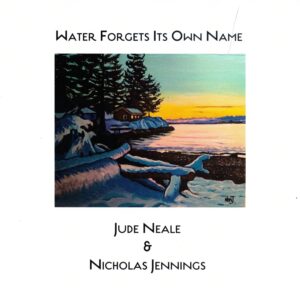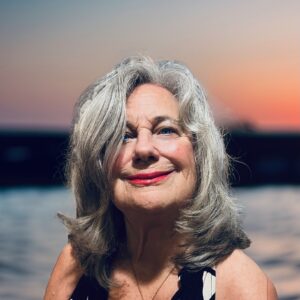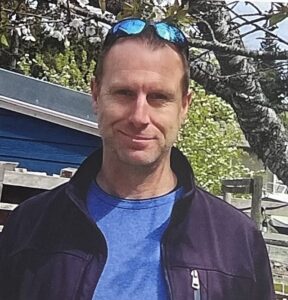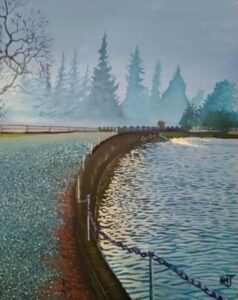The ‘colour of everyday miracles’
Water Forgets Its Own Name
by Jude Neale & Nicholas Jennings
Victoria: Ekstasis Editions, 2023
$27.95 / 9781771715300
Reviewed by Mary Ann Moore
*

Jude Neale has appreciated living on Bowen Island, Nex̱wlélex̱wm, the unceded traditional land of the Sḵwx̱wú7mesh Nation, for four decades and savours and celebrates that appreciation in her poetry. Both she and artist Nicholas Jennings acknowledge the island’s “first storytellers.”
Jennings was coping with severe PTSD when he moved to Bowen Island. He quickly realized that the paintings he felt driven to create for their therapeutic value also helped him build ties to the community.
When Neale suggested they collaborate, Jennings was flattered and “blown away by this exciting concept.” His vibrant canvases in Water Forgets Its Own Name, in watercolour, acrylic, and oil, centre on Bowen Island (with one exception). Beaches, docks, creeks, sunsets, and winding trails leap from Water’s pages.

While this collaboration is their first, Neale has collaborated in the past with musicians, dancers, other artists, filmmakers, and fellow poets. She sees her poems as “saturated with the light and colour of everyday miracles seen through Nicholas Jennings paintings.” Future collaborations will involve Jennings and others in separate creative projects.
Neale’s poems, “pressed like flowers between [the book’s] pages,” weave memories of skipping stones onto the “mirrored sea” with a five-year old, and gathering pebbles in a drawstring purse. Set alongside Jennings’ paintings, the poems honour such memories as well as specific places on Bowen Island such as Crayola Beach, Cates Bay, Buchanan Road, Mount Gardner, Cape Roger Curtis, and Tunstall Bay.

Water Forgets Is Own Name is Neale’s twelfth book. In one of her earlier ones published in 2014, A Quiet coming of Light: A Poetic Memoir,” she writes of surviving childhood, family relationships, and the complexities of loss. At that time, Neale wrote: “I do not trust each shiny day but am cautiously grateful for my glimpse into the spectacular.”
A prolific visual artist, Jennings moved to Canada from the UK in 2005 to be closer to his father, who’d retired from Simon Fraser University. He recently adopted the use of oils as his primary medium and continues to paint in watercolour using a technique he developed “which subverts conventional approaches.”

“The Causeway,” an acrylic painting by Jennings, is particularly beautiful with its variety of blues and depiction of fog among the tall Douglas fir trees.
“Causeway in Fog,” Neale’s accompany poem, begins:
This is a place which aches
for the bloom of shimmer,
that’s held in water –
still sleepy with the weight of blue.
I’ve been to Bowen Island in summer and in winter and remember writing my own poem, “What the Lake Knows,” about Killarney Lake. Jennings’ acrylic painting of the lake shows its blue water and numerous lily pads, one with a heart shape. It’s an image I stopped at when first looking through the book, as the painting’s vitality of colour and movement drew my eye.
In “Where Lilies Grow,” her accompanying poem, Neale writes—
This lake reflects
back half my life.
She has seen me run
its circumference over
and over, when I tried to
chase guilt and make
my body disappear.
She saw me
weep when love, lost. . .
Neale’s poems appear spare. And yet in a few words, each depicts a scene and tells a story. “Where Lilies Grow” follows the seasons of the lake and the speaker’s journey through her own life seasons reflected there.
“Water Forgets Its Own Name” is a three-line poem, and perhaps that titular line arrived for the poet without the necessity to know what it “means.” We readers could spend time on that or let the line trickle as the creek does towards “a swollen lake.”
The accompanying painting— “Creek on Mike’s Lorg Trail”—is vivid with blue, green, and unexpected purple in a creek edged with mossy rocks and ferns.
The word “lorg” was new to me and looking it up I found that it’s a term from Old Irish meaning “to track, trace, leave a mark.”

“Extravagant colour” is a phrase Neale uses in her poem “Fleeting” and could describe Jennings’ paintings, particularly his watercolour “Cape Roger Curtis Sunset.” In her accompanying poem, Neale refers to a “melon sky” and “clouds that change / from coral to indigo. / Being here, right here, is a blessing….”
The term ekphrastic hasn’t been used to describe Neale’s poems either by the poet, the artist, or in their cover endorsements. Perhaps that’s because the poems are not written specifically about each painting but about the place depicted of which Neale has personal experience.
There may not be a word, a name for this practice; rather, we can take pleasure in the poetry and visual art, a blessing of everyday miracles expressed with a gentle gratitude.
*

Mary Ann Moore is a poet, writer, and writing mentor who lives on the unceded lands of the Snuneymuxw First Nation in Nanaimo. Her full-length book of poetry is Fishing for Mermaids (Leaf Press, 2014) and she has a new chapbook of poems called Mending (house of appleton). Moore leads writing circles and has two writing resources: Writing to Map Your Spiritual Journey (International Association for Journal Writing) and Writing Home: A Whole Life Practice (Flying Mermaids Studio). She writes a blog here. [Editor’s note: Mary Ann Moore has also reviewed books by Yvonne Blomer and DC Reid, Marita Dachsel and Nancy Lee (eds.) Lisa Ahier, with Susan Musgrave, Stephen Collis (ed.), Maria Coffey, Lorna Crozier, Katherine Palmer Gordon, and Donna McCart Sharkey & Arleen Paré for BCR.]
*
The British Columbia Review
Interim Editors, 2023-25: Trevor Marc Hughes (nonfiction), Brett Josef Grubisic (fiction)
Publisher: Richard Mackie
Formerly The Ormsby Review, The British Columbia Review is an on-line book review and journal service for BC writers and readers. The Advisory Board now consists of Jean Barman, Wade Davis, Robin Fisher, Barry Gough, Hugh Johnston, Kathy Mezei, Patricia Roy, Maria Tippett, and Graeme Wynn. Provincial Government Patron (since September 2018): Creative BC. Honorary Patron: Yosef Wosk. Scholarly Patron: SFU Graduate Liberal Studies. The British Columbia Review was founded in 2016 by Richard Mackie and Alan Twigg.
“Only connect.” – E.M. Forster